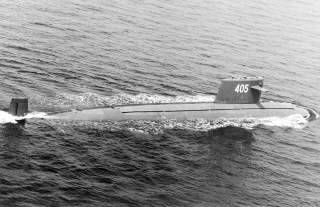China's Very First Nuclear Attack Submarines Had Some Major Fatal Flaws
Submarines are suppose to be stealthy. Beijing, it seems, did not get the memo.
In 1974, the People’s Liberation Army Navy (PLAN) accepted delivery of the country’s first nuclear-powered submarine. Long a cherished goal of Chairman Mao himself, the design was initially a disappointment. Despite their less than ideal performance, the Type 091 Han-class submarines will ultimately be remembered as Asia’s first indigenously produced nuclear attack submarines.
According to historian Benjamin Lai, author of The Dragon’s Teeth, China first expressed interest in developing nuclear missile submarines as early as 1958. The project then stalled for several years, a period coinciding with the Great Leap Forward, but was revived in 1965. Beijing ultimately decided on a more pragmatic approach, building an attack submarine first and only then a missile submarine. The reasoning was that to produce an attack submarine, China would only need to master the reactor technology to be successful, while a nuclear ballistic missile submarine required mastery of the reactor, a missile and the underwater launch system.
In many ways, this “walk before you run” strategy paralleled the American effort to build an SSBN as the Americans first built the Skipjack-class nuclear attack subs and then modified them into the missile-carrying George Washington class. The Chinese defense industry set to work, with designer Peng Shilu initially leading the effort. (Eventually his role would be taken over by Huang Xuhua, who later worked on the Type 092 ballistic missile submarine project.)
Unlike the Americans, who built world-class submarines and were the first to utilize underwater nuclear propulsion, the Chinese were at a serious technological disadvantage. That was evident in what came to be known as the Type 091 class submarine.The submarines were produced at the Bohai Shipyards in Huludao. The keel for the first submarine, pennant number 401, was laid in 1968 and completed in 1974. Four more submarines followed, the last being completed in 1991.
The slow production rate hints at serious engineering issues. The first submarine took seven years to complete. The second took three years to complete, while the last three each took only one year to complete. According to the authoritative Combat Fleets of the World, the subs early on were known within the PLAN as “sharks without teeth.” Overall, it took twenty-one years to complete just five submarines.
The Type 091 class weighs 5,500 tons submerged. It has a length of approximately 321 feet and a beam of thirty-two feet. The boats feature a large sail reminiscent of the Soviet Type 636 Kilo-class submarines. The teardrop-style hull was an early effort to catch up to the States in submarine hull technology. In 2015, the now-defunct Want China Times reported that Huang Xuhua claimed he developed the Type 091 hull from two toy submarines imported from the United States and Hong Kong. While a nice story, it seems unlikely that Huang could have divined enough detail from a toy to bypass years of hydrodynamic research.
The Type 091 subs are equipped with six standard diameter 533-millimeter torpedo tubes. They utilize the French Thomson-Sintra DUUX-5 passive sonars, equipment that was purchased before the post–Tiananmen Square arms embargo. The system can track up to three targets simultaneously. The Type 091 can also lay sea mines.
One of the greatest, if not the greatest metric for a submarine is the ability to operate quietly and evade detection. The Type 091 has been described as a “relatively noisy submarine based on 1950s and 1960s technology.” Li Jie, a Beijing-based military expert, claimed that the Type 091s are “about 20 years behind US vessels,” and still posed a threat to U.S. carriers. Li also made the claim that during the 1996 Taiwan Strait crisis, two Type 091 submarines tracked the aircraft carriers USS Independence and USS Abraham Lincoln, “pushing the US carriers back 200 miles.”
The five Type 091 submarines were originally all based with the PLAN’s North Sea Fleet. The decision to base them all together was likely for logistical reasons, as it would be easier to maintain five nuclear reactors at a single facility. It should also be pointed out that the basing decision was made at a time when China considered the Soviet Union a much more serious threat than the United States.
Today, the Type 091 submarines are slowly being phased out. The first sub, 401, was decommissioned in 2000 and the second in 2004. In 2014, one paid a port call at Colombo, Sri Lanka. The following year, one Type 091 accompanied China’s rotation of ships posted to antipiracy duties off the Horn of Africa. The voyage from northern China to off the coast of Somalia is nearly eight thousand miles long, and may be the longest ever taken by a Chinese nuclear submarine. This suggests that, more than four decades after the ships were first built, the kinks in the design have been finally worked out and Type 091 class is now thoroughly reliable.
In October of last year, China Daily reported the first of the Type 091s was towed to the Chinese Navy Museum in Qingdao, where it will become a permanent exhibit. The reactor and all nuclear material have been removed for the exhibition.
Meanwhile, the PLAN is pushing ahead with new submarines. Three Type 093B submarines were launched in 2015 alone, and a Type 095 is considered imminent. While the Type 091 may be remembered as a crude effort, it was ultimately a successful one, and an important first step in China’s self-sufficiency in nuclear submarines.
Kyle Mizokami is a defense and national-security writer based in San Francisco who has appeared in the Diplomat, Foreign Policy, War is Boring and the Daily Beast. In 2009 he cofounded the defense and security blog Japan Security Watch. You can follow him on Twitter: @KyleMizokami.
Image: Chinese Navy Han-class nuclear-powered attack submarine No. 405. Wikimedia Commons/U.S. Navy

